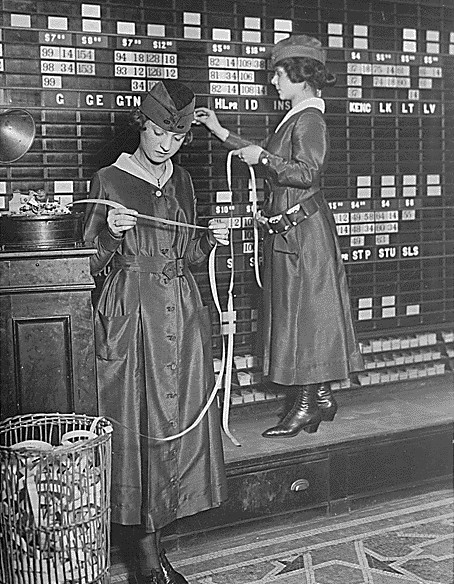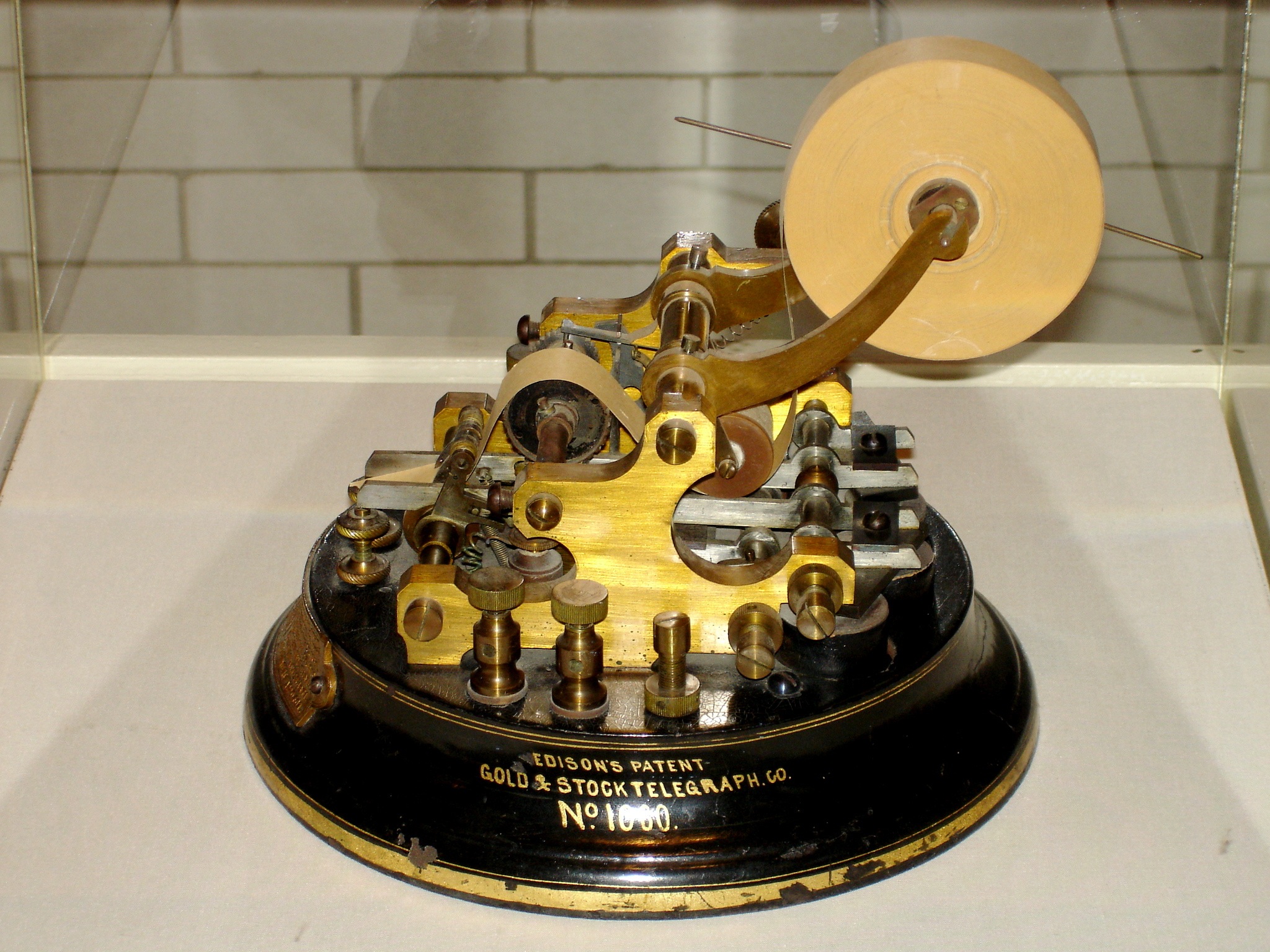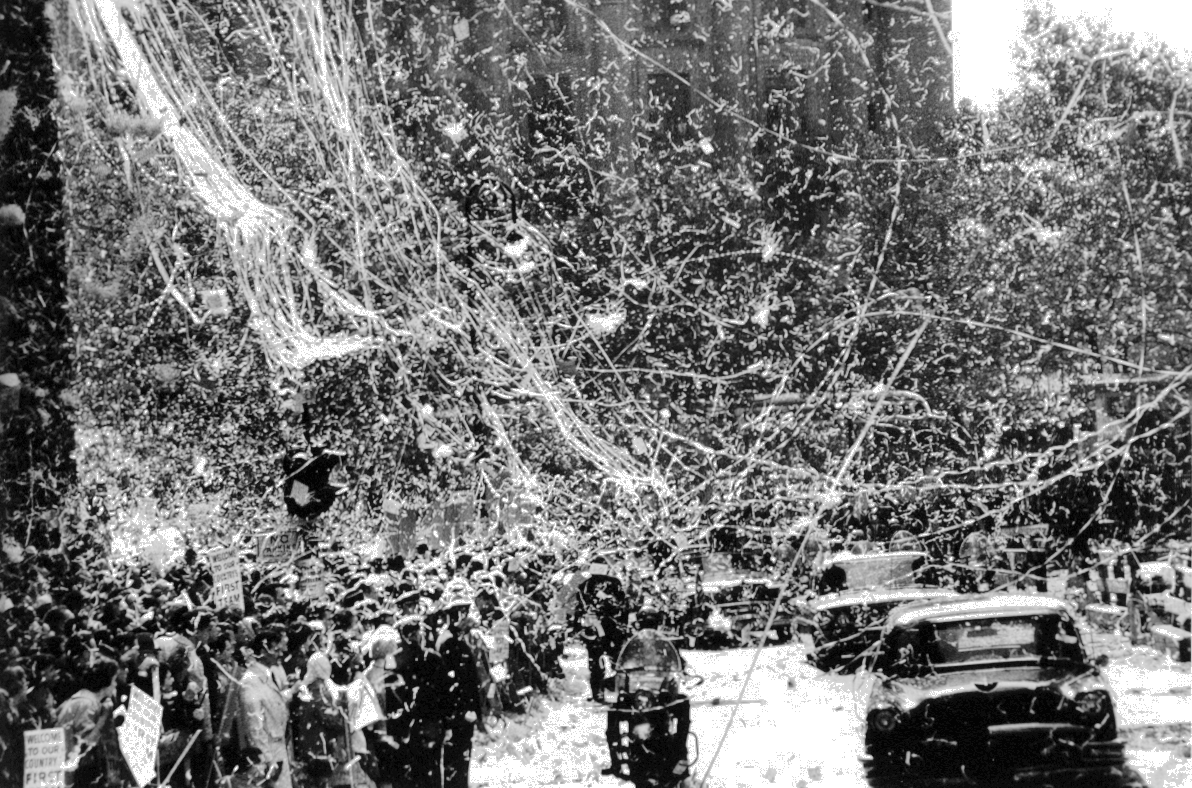Ticker Tape on:
[Wikipedia]
[Google]
[Amazon]
 Ticker tape was the earliest electrical dedicated financial communications medium, transmitting stock price information over
Ticker tape was the earliest electrical dedicated financial communications medium, transmitting stock price information over
 By the 1880s, there were about a thousand stock tickers installed in the offices of New York bankers and brokers. In 1890, members of the exchange agreed to create the New York Quotation Co., buying up all other ticker companies to ensure accuracy of reporting of price and volume activity.
By the 1880s, there were about a thousand stock tickers installed in the offices of New York bankers and brokers. In 1890, members of the exchange agreed to create the New York Quotation Co., buying up all other ticker companies to ensure accuracy of reporting of price and volume activity.
 Stock ticker machines are an ancestor of the modern
Stock ticker machines are an ancestor of the modern
 Used ticker tape was used as confetti, to be thrown from the windows above parades either cut up into scraps or thrown as whole spools, primarily in lower
Used ticker tape was used as confetti, to be thrown from the windows above parades either cut up into scraps or thrown as whole spools, primarily in lower Glenn's second ticker tape parade
BBC News, November 17, 1998 Ticker tape parades generally celebrated some significant event, such as the end of
Exchanges - Ticker Tape Terminology
The Investment FAQ. 19 September 1999. 20 April 2007
Engineering and Technology History Wiki: The Stock TickerThe Stock Ticker Company: History of ticker machines.Telegraph History: Some Early Days of Western Union's Stock Ticker Service, 1871-1910
by Charles R. Tilghman {{DEFAULTSORT:Ticker Tape Stock market Office equipment Thomas Edison History of telecommunications American inventions Telegraphy
 Ticker tape was the earliest electrical dedicated financial communications medium, transmitting stock price information over
Ticker tape was the earliest electrical dedicated financial communications medium, transmitting stock price information over telegraph
Telegraphy is the long-distance transmission of messages where the sender uses symbolic codes, known to the recipient, rather than a physical exchange of an object bearing the message. Thus flag semaphore is a method of telegraphy, whereas ...
lines, in use from around 1870 through 1970. It consisted of a paper strip that ran through a machine called a stock ticker, which printed abbreviated company names as alphabetic symbols followed by numeric stock transaction price and volume information. The term "ticker" came from the sound made by the machine as it printed.
The ticker tape revolutionized financial markets, as it relayed information from trading floors continuously and simultaneously across geographical distances. Paper ticker tape became obsolete in the 1960s, as television and computers were increasingly used to transmit financial information. The concept of the stock ticker lives on, however, in the scrolling electronic tickers seen on brokerage walls and on news and financial television channels.
Ticker tape stock price telegraphs were invented in 1867 by Edward A. Calahan
Edward Augustin Calahan (1838–1912) was an American inventor, credited with invention of a ticker tape, gold and stock tickers, and a multiplex telegraph system.
Calahan was born in Boston, Massachusetts. He left school at the age of 11 to pu ...
, an employee of the American Telegraph Company
American(s) may refer to:
* American, something of, from, or related to the United States of America, commonly known as the "United States" or "America"
** Americans, citizens and nationals of the United States of America
** American ancestry, pe ...
who later founded The ADT Corporation.
History
Although telegraphic printing systems were first invented by Royal Earl House in 1846, early models were fragile, required hand-cranked power, frequently went out of synchronization between sender and receiver, and did not become popular in widespread commercial use. David E. Hughes improved the printing telegraph design with clockwork weight power in 1856, and his design was further improved and became viable for commercial use whenGeorge M. Phelps
George May Phelps (March 19, 1820 – May 18, 1888) was a 19th-century American inventor of automated telegraphy equipment. He is credited with synthesizing the designs of several existing printers into his line of devices which became the domi ...
devised a resynchronization system in 1858. The first stock price ticker system using a telegraphic printer was invented by Edward A. Calahan
Edward Augustin Calahan (1838–1912) was an American inventor, credited with invention of a ticker tape, gold and stock tickers, and a multiplex telegraph system.
Calahan was born in Boston, Massachusetts. He left school at the age of 11 to pu ...
in 1863; he unveiled his device in New York City on November 15, 1867. Early versions of stock tickers provided the first mechanical means of conveying stock prices ("quotes"), over a long distance via telegraph wiring. In its infancy, the ticker used the same symbols as Morse code
Morse code is a method used in telecommunication to encode text characters as standardized sequences of two different signal durations, called ''dots'' and ''dashes'', or ''dits'' and ''dahs''. Morse code is named after Samuel Morse, one ...
as a medium for conveying messages. One of the earliest practical stock ticker machines, the Universal Stock Ticker developed by Thomas Edison
Thomas Alva Edison (February 11, 1847October 18, 1931) was an American inventor and businessman. He developed many devices in fields such as electric power generation, mass communication, sound recording, and motion pictures. These inventi ...
in 1869, used alphanumeric characters with a printing speed of approximately one character per second.
Previously, stock prices had been hand-delivered via written or verbal messages. Since the useful time-span of individual quotes is very brief, they generally had not been sent long distances; aggregated summaries, typically for one day, were sent instead. The increase in speed provided by the ticker allowed for faster and more exact sales. Since the ticker ran continuously, updates to a stock's price whenever the price changed became effective much faster and trading became a more time-sensitive matter. For the first time, trades were being done in what is now thought of as near real-time.
 By the 1880s, there were about a thousand stock tickers installed in the offices of New York bankers and brokers. In 1890, members of the exchange agreed to create the New York Quotation Co., buying up all other ticker companies to ensure accuracy of reporting of price and volume activity.
By the 1880s, there were about a thousand stock tickers installed in the offices of New York bankers and brokers. In 1890, members of the exchange agreed to create the New York Quotation Co., buying up all other ticker companies to ensure accuracy of reporting of price and volume activity.
Technology
 Stock ticker machines are an ancestor of the modern
Stock ticker machines are an ancestor of the modern computer printer
In computing, a printer is a peripheral machine which makes a persistent representation of graphics or text, usually on paper. While most output is human-readable, bar code printers are an example of an expanded use for printers. Diffe ...
, being one of the first applications of transmitting text over a wire to a printing device, based on the printing telegraph. This used the technology of the then-recently invented telegraph machines, with the advantage that the output was readable text, instead of the dots and dashes of Morse code
Morse code is a method used in telecommunication to encode text characters as standardized sequences of two different signal durations, called ''dots'' and ''dashes'', or ''dits'' and ''dahs''. Morse code is named after Samuel Morse, one ...
. A special typewriter designed for operation over telegraph wires was used at the opposite end of the telegraph wire connection to the ticker machine. Text typed on the typewriter was displayed on the ticker machine at the opposite end of the connection.
The machines printed a series of '' ticker symbols'' (usually shortened forms of a company's name), followed by brief information about the price of that company's stock; the thin strip of paper on which they were printed was called ''ticker tape''. The word ''ticker'' comes from the distinct tapping (or ''ticking'') noise the machines made while printing. Pulses on the telegraph line made a letter wheel turn step by step until the correct symbol was reached and then printed. A typical 32-symbol letter wheel had to turn on average 15 steps until the next letter could be printed resulting in a very slow printing speed of one character per second. In 1883, ticker transmitter keyboards resembled the keyboard of a piano with black keys indicating letters and the white keys indicating numbers and fractions, corresponding to two rotating type wheels in the connected ticker tape printers.
Newer and more efficient tickers became available in the 1930s, but these newer and better tickers still had an approximate 15-to-20-minute delay. Ticker machines became obsolete in the 1960s, replaced by computer network
A computer network is a set of computers sharing resources located on or provided by network nodes. The computers use common communication protocols over digital interconnections to communicate with each other. These interconnections are ...
s; none have been manufactured for use for decades. However, working reproductions of at least one model are now being manufactured for museums and collectors.
Simulated ticker displays, named after the original machines, still exist as part of the display of television news channels and on some websites—see news ticker. One of the most famous outdoor displays is the simulated ticker scrolling marquee located at One Times Square in New York City.
Ticker tapes then and now contain generally the same information. The ticker symbol is a unique set of characters used to identify the company. The shares traded is the volume for the trade being quoted. Price traded refers to the price per share of a particular trade. Change direction is a visual cue showing whether the stock is trading higher or lower than the previous trade, hence the terms ''downtick'' and '' uptick''. Change amount refers to the difference in price from the previous day's closing. Many today include color to indicate whether a stock is trading higher than the previous day's (green), lower than previous (red), or has remained unchanged (blue or white).
Other uses
Baseball
In the early days ofbaseball
Baseball is a bat-and-ball sport played between two teams of nine players each, taking turns batting and fielding. The game occurs over the course of several plays, with each play generally beginning when a player on the fielding t ...
, before electronic scoreboards, manual score turners used a ticker to get the latest scores from around the league. Today, computers and electronic scoreboards have replaced the manual scoreboard and the ticker.
Parades
 Used ticker tape was used as confetti, to be thrown from the windows above parades either cut up into scraps or thrown as whole spools, primarily in lower
Used ticker tape was used as confetti, to be thrown from the windows above parades either cut up into scraps or thrown as whole spools, primarily in lower Manhattan
Manhattan (), known regionally as the City, is the most densely populated and geographically smallest of the five boroughs of New York City. The borough is also coextensive with New York County, one of the original counties of the U.S. state ...
; this became known as a ticker tape parade.BBC News, November 17, 1998 Ticker tape parades generally celebrated some significant event, such as the end of
World War I
World War I (28 July 1914 11 November 1918), often abbreviated as WWI, was List of wars and anthropogenic disasters by death toll, one of the deadliest global conflicts in history. Belligerents included much of Europe, the Russian Empire, ...
and World War II
World War II or the Second World War, often abbreviated as WWII or WW2, was a world war that lasted from 1939 to 1945. It involved the World War II by country, vast majority of the world's countries—including all of the great power ...
, or the safe return of one of the early astronaut
An astronaut (from the Ancient Greek (), meaning 'star', and (), meaning 'sailor') is a person trained, equipped, and deployed by a human spaceflight program to serve as a commander or crew member aboard a spacecraft. Although generally r ...
s.
Ticker tape parades are still held in New York City
New York, often called New York City or NYC, is the List of United States cities by population, most populous city in the United States. With a 2020 population of 8,804,190 distributed over , New York City is also the L ...
, specifically in the "Canyon of Heroes
Broadway () is a road in the U.S. state of New York. Broadway runs from State Street at Bowling Green for through the borough of Manhattan and through the Bronx, exiting north from New York City to run an additional through the Westcheste ...
" in Manhattan, most often when local sports teams win a championship. However, actual ticker tape is not used any longer during these parades; often, pieces of paper from paper shredder
A paper shredder is a mechanical device used to cut sheets of paper into either strips or fine particles. Government organizations, businesses, and private individuals use shredders to destroy private, confidential, or otherwise sensitive docum ...
s are used as a convenient source of confetti.
Art
Ticker tape was also incorporated into some of the weaver Dorothy Liebes' unusual art textiles.See also
*Commodity tick Futures exchanges establish a minimum amount that the price of a commodity can fluctuate upward or downward. This minimum fluctuation (trade increment) is known as a tick or commodity tick. Hence, a tick is any fluctuation in the price of a security ...
*Don't fight the tape
Trend following or trend trading is a trading strategy according to which one should buy an asset when its price trend goes up, and sell when its trend goes down, expecting price movements to continue.
There are a number of different techniques ...
*Punched tape
Five- and eight-hole punched paper tape
Paper tape reader on the Harwell computer with a small piece of five-hole tape connected in a circle – creating a physical program loop
Punched tape or perforated paper tape is a form of data storage ...
* Stock market data systems
* Telex
*Teleprinter
A teleprinter (teletypewriter, teletype or TTY) is an electromechanical device that can be used to send and receive typed messages through various communications channels, in both point-to-point and point-to-multipoint configurations. Init ...
References
External links
Exchanges - Ticker Tape Terminology
The Investment FAQ. 19 September 1999. 20 April 2007
by Charles R. Tilghman {{DEFAULTSORT:Ticker Tape Stock market Office equipment Thomas Edison History of telecommunications American inventions Telegraphy